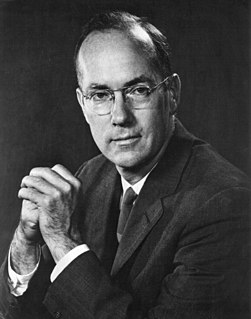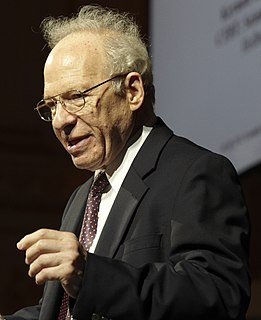Alan Bicksler Fowler (born October 15, 1928) is an American physicist. [1]
Alan Bicksler Fowler (born October 15, 1928) is an American physicist. [1]
He was born in Denver, Colorado on October 15, 1928. [2]
Fowler served in the U.S. Army from 1946 to 1948 and from 1952 to 1953. [3]
He earned a BS in 1951, then an MS in 1952 from Rensselaer Polytechnic Institute in Troy, New York. In 1958, he earned his PhD from Harvard University. [2]
Fowler was married to Kathleen Devlin for 65 years, until her death in 2016, with whom he had two sons and two daughters. [4]
He is a member of the National Academy of Sciences. [5]
He worked as a researcher for Raytheon Technologies, from 1953 to 1956, [2] [6] and for IBM Thomas J. Watson Research Center from 1958 to 1993, and was a member of the IBM MOS research group. [7]
He is an IBM Fellow Emeritus. [2]
Fowler is named as a co-inventor in nine U.S. Patents. [8]
Fowler was awarded the Oliver E. Buckley Condensed Matter Prize by the American Physical Society in 1988. [2]

Walter Houser Brattain was an American physicist at Bell Labs who, along with fellow scientists John Bardeen and William Shockley, invented the point-contact transistor in December 1947. They shared the 1956 Nobel Prize in Physics for their invention. Brattain devoted much of his life to research on surface states.

Charles Hard Townes was an American physicist. Townes worked on the theory and application of the maser, for which he obtained the fundamental patent, and other work in quantum electronics associated with both maser and laser devices. He shared the 1964 Nobel Prize in Physics with Nikolay Basov and Alexander Prokhorov. Townes was an adviser to the United States Government, meeting every US president from Harry S. Truman (1945) to Bill Clinton (1999).
Rolf William Landauer was a German-American physicist who made important contributions in diverse areas of the thermodynamics of information processing, condensed matter physics, and the conductivity of disordered media. In 1961 he discovered Landauer's principle, that in any logically irreversible operation that manipulates information, such as erasing a bit of memory, entropy increases and an associated amount of energy is dissipated as heat. This principle is relevant to reversible computing, quantum information and quantum computing. He also is responsible for the Landauer formula relating the electrical resistance of a conductor to its scattering properties. He won the Stuart Ballantine Medal of the Franklin Institute, the Oliver Buckley Prize of the American Physical Society and the IEEE Edison Medal, among many other honors.

Stuart Stephen Papworth Parkin is an experimental physicist, IBM Fellow and manager of the magnetoelectronics group at the IBM Almaden Research Center in San Jose, California. He is also a consulting professor in the Department of Applied Physics at Stanford University and director of the IBM-Stanford Spintronic Science and Applications Center, which was formed in 2004.
Craig Jon Hawker is an Australian-born chemist. His research has focused on the interface between organic and polymer chemistry, with emphasis on the design, synthesis, and application of well-defined macromolecular structures in biotechnology, microelectronics, and surface science. Hawker holds more than 45 U.S. patents, and he has co-authored over 300 papers in the areas of nanotechnology, materials science, and chemistry. He was listed as one of the top 100 most cited chemists worldwide over the decade 1992–2002, and again in 2000–2010.

Richard Lawrence Garwin is an American physicist, best known as the author of the first hydrogen bomb design.

Gerd Binnig is a German physicist. He is most famous for having won the Nobel Prize in Physics jointly with Heinrich Rohrer in 1986 for the invention of the scanning tunneling microscope.
Rangaswamy Srinivasan is a physical chemist and inventor with a 30-year career at IBM Research. He has developed techniques for ablative photodecomposition and used them to contribute to the development of LASIK eye surgery.
Maurice Karnaugh is an American physicist, mathematician and inventor known for the Karnaugh map used in Boolean algebra.
Chih-Tang "Tom" Sah is a Chinese-American electronics engineer and condensed matter physicist. He is best known for inventing CMOS logic with Frank Wanlass at Fairchild Semiconductor in 1963. CMOS is now used in nearly all modern very large-scale integration (VLSI) semiconductor devices.

Harm Peter Hofstee is a Dutch physicist and computer scientist who currently is a distinguished research staff member at IBM Austin, USA, and a part-time professor in Big Data Systems at Delft University of Technology, Netherlands.

Christoph Gerber is a titular professor at the Department of Physics, University of Basel, Switzerland.
Samuel E. Blum was an American chemist and physicist. He was a researcher at the Battelle Memorial Institute in Columbus, Ohio, working for government and private companies. He worked with semiconductor materials, which was his specialization until his retirement from IBM Watson Research Center in 1990.

Peter Pitirimovich Sorokin was an American Russian physicist and co-inventor of the dye laser. He was born in Boston and grew up in Winchester, Massachusetts. He attended Harvard University, receiving a BA degree in 1952 and a PhD in Applied Physics in 1958; his PhD thesis adviser was Nicolaas Bloembergen.
George Bekefi was a plasma physicist, a professor at MIT, and an inventor.

Judith Louise MacManus-Driscoll is a Professor of Materials Science at the University of Cambridge. She is a Fellow of the Institute of Physics (IOP), the Institute of Materials, Minerals and Mining (IOM3), the Materials Research Society (MRS) and the American Physical Society (APS).

James (Jim) U. Lemke was an American physicist and entrepreneur who lived in San Diego. He developed magnetic recording and internal combustion engine technologies.
Ali Enver Aliev is a Crimean Tatar American physicist, research professor at the NanoTech Institute, and adjunct professor at Physics Department, The School of Natural Sciences and Mathematics, University of Texas at Dallas. In 2011 he was recognized an “Inventor of the year” by Time magazine His fields of current research interest are nanoscience and nanotechnologies, electrochromism and acoustics. He holds a number of invention patents from the United States Patent and Trademark Office (USPTO).